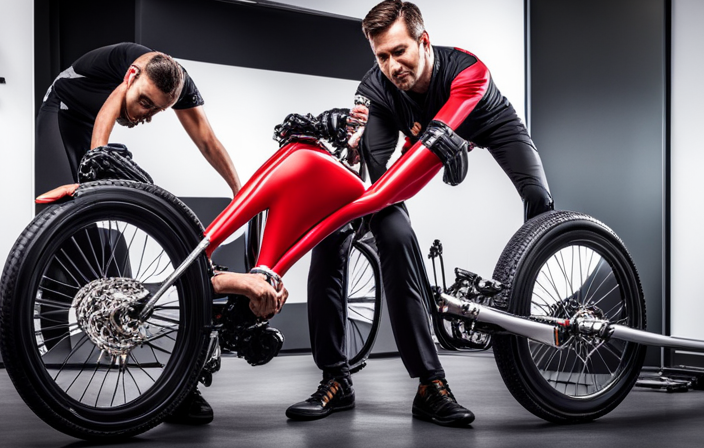Constructing a tandem bicycle is an enjoyable and fulfilling endeavor for bike enthusiasts. Speaking from experience, having crafted multiple tandem bicycles myself, I can affirm that meticulous planning and a keen eye for detail are essential components of the process.
From choosing the right frame to assembling the various components, every step of the process requires precision and technical know-how.
In this article, I will guide you through the process of building your own tandem bicycle. We will start by discussing the different types of frames available and how to choose the right one for your needs.
Then, we will move on to selecting the components, including the wheels, brakes, and drivetrain. Finally, we will cover the crucial steps of assembling and testing your tandem bike to ensure that it is both safe and roadworthy.
Whether you are building a tandem bike for racing or leisurely rides with a friend, this guide will provide you with all the information you need to get started.
Key Takeaways
- The frame material and design should be carefully considered for a tandem bicycle.
- Components such as pedals and handlebars should be chosen based on personal preferences and riding style.
- Proper maintenance and communication with your partner are crucial for a safe and enjoyable tandem ride.
- Regular inspections and cleaning can prevent common issues and costly repairs.
Choose the Right Frame
Choosing the right frame is crucial when making a tandem bicycle, so don’t rush the decision and make sure you find one that fits your needs and preferences.
When it comes to material options, you can choose from aluminum, carbon, steel, or titanium. Aluminum is lightweight and affordable, while carbon is the lightest and most expensive. Steel is durable and has a classic look, and titanium is strong and lightweight but comes with a higher price tag.
Custom designs are also an option if you want to personalize your tandem bike. You can choose the length, height, and angle of the frame to suit your body size and riding style. Consider the intended use of the bike, such as touring or racing, to ensure the frame is suitable for your needs.
Once you’ve selected the right frame, the next step is to choose the components that will make up the rest of the bike.
Selecting Components
When it comes to putting together your tandem bicycle, selecting the right components is crucial. One of the most important components you’ll need to choose is the pedals. There are a variety of pedal options available, including clipless pedals, platform pedals, and toe clip pedals. Consider your riding style and personal preferences when selecting your pedals.
Clipless pedals may be best for experienced riders who want maximum efficiency, while platform pedals may be better for riders who want more freedom to adjust their foot position.
Another key component to consider is the handlebars. There are a variety of handlebar styles to choose from, including drop bars, flat bars, and cruiser bars. Each type of handlebar offers different riding positions and benefits.
Drop bars may be best for long rides or racing, while flat bars may be better for more casual riding. Consider your comfort and riding style when selecting your handlebars.
Picking the right pedals and handlebars will ensure that your tandem bike is comfortable and efficient to ride.
Now, let’s move on to assembling your tandem.
Assembling Your Tandem
Assembling your tandem can be a thrilling experience, bringing you one step closer to hitting the open road with your partner. However, it’s important to take the time to ensure that everything is put together correctly.
Begin by adjusting the bike’s fit to make sure that both riders are comfortable and able to pedal efficiently. This includes adjusting the saddle height, handlebar height, and stem length to fit each rider’s body proportions.
Another important aspect to consider when assembling your tandem is communication while riding. Since you’ll be riding in close proximity to your partner, it’s crucial to establish a system of communication beforehand.
This can include hand signals, verbal cues, or even a non-verbal system such as tapping on the back of the rider in front of you to indicate a turn. By establishing clear communication, you can ensure that both riders are on the same page and able to navigate the road safely.
Moving forward, it’s important to keep in mind that safety and roadworthiness are of utmost importance when riding a tandem bike.
Safety and Roadworthiness
To ensure your safety and the roadworthiness of your tandem, it’s important to regularly inspect and maintain the bike, just like a car needs regular oil changes to keep it running smoothly. Here are some key steps to follow to ensure that your tandem is safe and ready to ride:
-
Proper Training: Riding a tandem bicycle requires different skills than riding a regular bike. It’s important to take the time to learn how to handle the bike, communicate effectively with your partner, and navigate different terrain and traffic situations. Consider taking a tandem-specific class or working with a coach to improve your skills.
-
Riding Etiquette: As with any type of cycling, there are certain rules of the road that you should follow to ensure your safety and the safety of others. Be sure to signal your turns and stops, ride predictably, and communicate clearly with your partner and other riders.
-
Regular Inspections: Before each ride, take a few minutes to check your tandem for any signs of wear or damage. Check the brakes, tires, chain, and other components to make sure they’re in good working order.
-
Maintenance and Care: In addition to regular inspections, your tandem will also need routine maintenance to keep it running smoothly. This may include cleaning and lubricating the chain, adjusting the brakes and shifting, and replacing worn parts as needed.
By following these steps, you can ensure that your tandem is safe, reliable, and ready for your next ride.
In the next section, we’ll discuss some tips for maintaining and caring for your bike over the long term.
Maintenance and Care
As a tandem bicycle owner, it’s important to regularly check and clean your bike to ensure it remains in top condition. Addressing any issues promptly can prevent further damage and extend the life of your tandem.
With proper maintenance and care, you can enjoy riding your tandem for years to come.
Regularly Check and Clean Your Tandem
Make sure you’re keeping your tandem in tip-top shape by regularly checking and cleaning it, so you can enjoy a smooth ride every time. Preventive maintenance is crucial to keep your tandem running efficiently.
Before you ride, make sure to check the tires’ pressure, brakes, chains, and gears. These parts are prone to wear and tear, so it’s important to inspect them regularly. If you notice any loose parts or unusual noises, it’s best to address the issue promptly to prevent further damage.
Cleaning your tandem regularly is just as important as checking it. Dirt, grime, and debris can accumulate on your bike, causing friction and damage to the components. Use a soft cloth or brush to clean the frame, wheels, and other parts.
Make sure to lubricate the chains, gears, and other moving parts after cleaning to keep them running smoothly. By regularly checking and cleaning your tandem, you can prevent common problems and ensure a safe and enjoyable ride. Address any issues promptly to avoid any further damage or safety concerns.
Address Any Issues Promptly
When you notice any issues with your bike, don’t delay in addressing them. Ignoring problems can lead to more costly repairs in the future. Did you know that delaying repairs can increase the cost by up to 50%? Dealing with conflicts is an essential part of maintaining a tandem bike. Communication strategies are crucial when you and your partner are experiencing problems with the bike. It’s necessary to communicate effectively and calmly, listen attentively, and address the issue promptly.
If you notice any strange noises or feel that the bike isn’t working correctly, stop and check it out. Here are some common issues that you may experience with your tandem and how to address them:
-
Loose or worn-out chains: Check the chains regularly and adjust or replace them if necessary.
-
Flat tires: Always carry a spare tube and tire lever when riding. Replace the tube or tire when you get a flat.
-
Brake issues: Make sure the brakes are functioning correctly and adjust them if needed. If you’re unsure, take the bike to a professional mechanic.
-
Loose bolts and screws: Check all bolts and tighten them if needed. If any bolts are missing, replace them immediately.
Remember, it’s better to address any issues promptly than to let them worsen. With proper maintenance and communication, you and your partner can enjoy riding your tandem for years to come.
Enjoy Riding Your Tandem!
You’re in for a thrilling experience as you take on the road with your tandem bike! There’s nothing quite like the feeling of working together with a partner to power your way through the wind and over hills. The benefits of tandem riding are numerous, from the increased speed and efficiency to the social aspect of sharing the ride with someone else.
But to make the most of your tandem experience, it’s important to follow a few tips. First and foremost, communication is key when riding a tandem bike. Make sure you and your partner are on the same page about the route, pace, and any potential obstacles.
It’s also important to maintain a consistent cadence and avoid sudden movements that could throw off your partner’s balance. And of course, don’t forget to enjoy the scenery and each other’s company as you ride. With a little practice and teamwork, tandem riding can be an incredibly rewarding and enjoyable activity.
Frequently Asked Questions
How much weight can a tandem bicycle hold?
"Are you wondering about the maximum capacity of a tandem bicycle? Well, it depends on the weight distribution. Typically, a tandem bike can hold up to 400-500 pounds, but it’s best to consult the manufacturer’s specifications."
What is the average cost of a tandem bicycle?
I recently purchased a tandem bicycle for an average cost of $1,000. Benefits of owning a tandem include increased communication and teamwork. Maintenance is crucial, so regularly clean the chain and inspect brakes.
How do you adjust the handlebars on a tandem bicycle?
Want to adjust your tandem bike’s handlebars? First, loosen the stem bolt and adjust the height to your preference. Then adjust the angle by loosening the faceplate bolts and rotating the handlebars. Tighten all bolts securely.
Can you ride a tandem bicycle by yourself?
Yes, it is possible to ride a tandem bicycle by yourself, but there are pros and cons to consider. Tips and tricks include adjusting the seat position and practicing balancing techniques. However, riding solo may not provide the full tandem experience.
What is the difference between a tandem bicycle and a regular bicycle?
A tandem bicycle has two riders pedaling in unison, making it faster and more efficient than a regular bike. However, communication and coordination are crucial, and finding a compatible partner is key.
Conclusion
In conclusion, building a tandem bicycle isn’t a task for the faint of heart. It requires technical expertise and a keen eye for detail. However, with the right frame, components, and assembly, you can create a machine that’s safe and roadworthy.
Like any other machine, a tandem bicycle requires regular maintenance and care to ensure its longevity. You must pay attention to the upkeep of your tandem, just as you would oil the gears of a clock or tighten the screws of a machine.
With proper care and attention, your tandem bicycle will be a reliable and enjoyable mode of transportation for many years to come. So, go ahead, take on the challenge, and create your own tandem bicycle – the road is waiting!
















